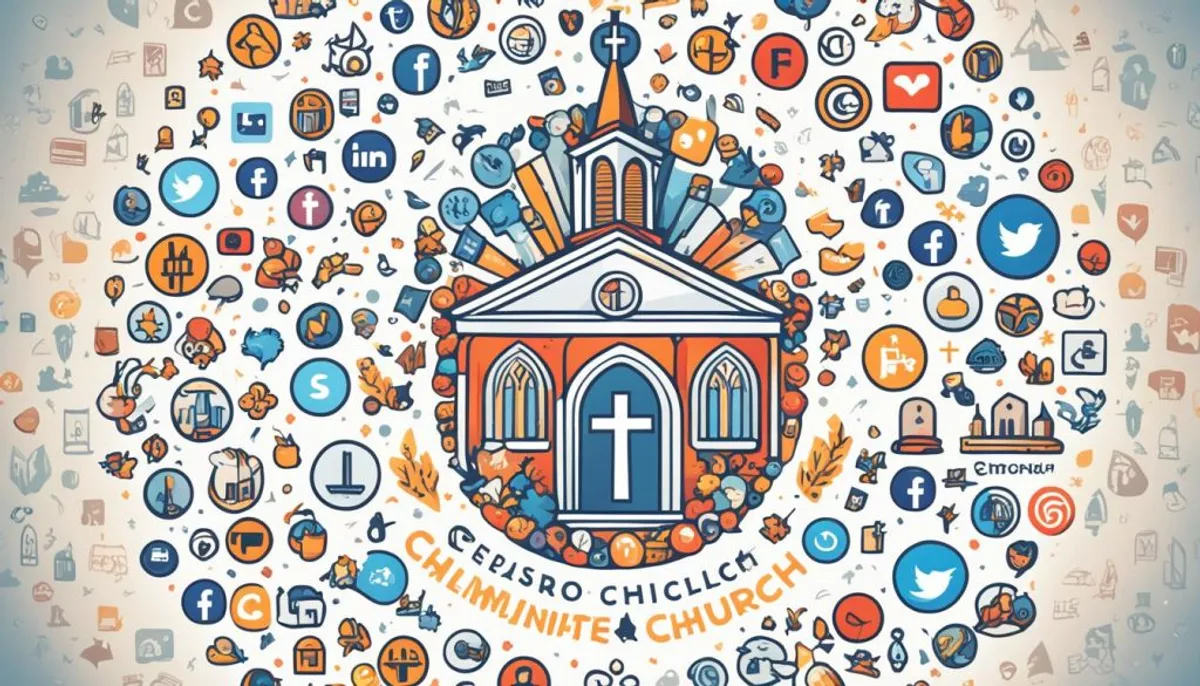Social media has changed how organizations interact with people. Churches have seen this too. It’s now key for churches to connect with their community, promote events, and share their messages. With social media, churches can reach different people, build strong connections, and truly impact their community.
We’re going to look at some expert advice on using social media to boost your church’s outreach. Whether you’re starting out or trying to improve your social media work, this is for you. Let’s explore social media for churches and see how it can bring your community together.

Key Takeaways:
- Social media is a powerful tool for churches to engage their community and share their message effectively.
- Engaging with social media platforms allows churches to reach diverse audiences and foster meaningful connections.
- Social media can help churches promote their events, increase attendance, and make a lasting impact on their community.
- By implementing an effective social media strategy, churches can energize their community and create positive change.
- Stay tuned for expert tips and strategies on how to make the most of social media for your church.
The Power of Social Media for Churches
Social media has transformed how churches connect with people. Facebook, Instagram, and YouTube help churches engage and inspire. They can reach more people, foster community, and support mental health by creating conversion-focused content.
It’s not just about likes or followers; it’s about making real connections. Churches can share faith and guidance through posts. Social media also allows for conversations and support, making people feel included.
Using social media lets churches reach beyond physical limits. It lets them connect with people far away. This makes the church accessible to more people, offering guidance to those seeking answers.
Social media is also a place for churches to support mental health. It’s a space for comfort, inspiration, and guidance. Churches can tackle mental health topics, offering help and a caring community.
When marketing churches on social media, being genuine is key. Content should speak to your audience. Live streams, positive messages, and community events can build an online community reflecting church values. However, churches also face finfluencers challenges that can complicate their outreach efforts.
Next, we’ll look at how social media benefits churches. It helps with community building, reaching new people, saving money on promotions, fundraising, and increasing volunteer efforts. Social media has great potential to positively impact churches online.
Five Remarkable Benefits of Social Media for Churches
Social media helps churches connect online. They can engage with followers and reach new people with a church social media strategy. Social media is great for church outreach and social media management for religious organizations. Let’s look at five key benefits for churches.
1. Sharing Faith and Building Communities
Social media lets church members share their faith and meet others who believe the same. Online groups and forums let members talk, support each other, and share stories. This builds a strong community, not just inside the church, but beyond its walls too.
2. Reaching New Audiences
Churches can find new people through social media. Platforms like Facebook, Instagram, and Twitter help share their message. Churches can reach more people with hashtags and ads. This helps connect with those seeking spiritual guidance or a faith community.
3. Cost-Effective Promotions
Social media is a cheap way for churches to promote events and initiatives. They can share details and stories without spending much. This helps churches save money and use resources better, making it a cost-effective promotion strategy for their outreach efforts.
4. Supporting Fundraising and Donations
Churches can boost fundraisers and donations on social media. They can use tools like Facebook’s or start campaigns on sites like GoFundMe. Sharing stories helps encourage more support for their cause.
5. Encouraging Volunteerism
Social media helps churches find volunteers. They can post about volunteer opportunities for community projects and charity drives. This gets more people involved in making a positive difference.
Social media lets churches reach more people and make a big impact. With a good church social media strategy, they can grow their community and spread faith. This promotes positive change in the world, including community engagement through social media.
Social Media Platforms for Churches
Social media helps churches connect with more people. Churches can use these tools to spread their message and bring communities together. Here are four great social media platforms for churches:
1. Facebook
Facebook lets churches keep in touch with their followers. It’s good for creating a community feel and getting people involved. Churches can live stream services, making it easy for everyone to join in, no matter where they are. They can also use Facebook Groups and Events to share news and connect with different groups in the church.
2. YouTube
YouTube is perfect for sharing church sermons and music. It lets churches reach people all over the world. Viewers can watch videos anytime. Churches can also talk with their congregation through comments and likes.
3. Instagram
Instagram is all about sharing stories through pictures and videos. It’s great for showing the heart of the church. With Stories, IGTV, and Reels, churches can share special moments and inspirational messages. Using the right hashtags helps find new people who might be interested. Instagram also has fun ways to talk with followers, like polls and questions.
4. TikTok
TikTok is a fun way for churches to share their faith with short videos. It’s a place to join in on trends and speak to a larger audience. The platform values real and down-to-earth content, which can attract younger viewers. Churches can use TikTok’s creative tools to make an impact in a way that feels right for the platform.
Churches should use Facebook, YouTube, Instagram, and TikTok to reach out and connect. Each platform has something unique to offer. By being active on these sites, churches can build their communities, offer support, and spread positivity far and wide. Additionally, maximizing engagement on instagram is essential for reaching a broader audience and fostering deeper connections.
Creating an Effective Church Social Media Strategy
A great church social media strategy helps keep the community together and engaged. To truly connect with your church members, know your audience, make content they’ll love, and be regular with your posts.
First, figure out what you want your church’s social media to achieve. Do you want more people at services, to highlight events, or to share hopeful messages? Having clear aims will make your strategy stronger.
Learn what interests your congregation and who they are. This info helps you make content that speaks to them directly. Try asking them directly or having chats to get useful info.
It’s vital to come up with content themes that grab your audience. Think about what your church believes in. What subjects or themes will your community like? Could you focus your content on regular events or celebrations?
“Crafting engaging content is crucial for capturing your audience’s attention.”
Being regular with postings is crucial for keeping people interested, especially when it comes to youtube monetization. Set a schedule for your posts that fits your church, and stick to it. Being consistent will keep your followers looking forward to updates.
Engage with your community often too. Always reply to comments, messages, and shout-outs quickly and with care. This shows you treasure your followers and helps build a tight-knit community.
By taking these steps and always checking if your strategy works, you can build a successful and meaningful social media presence focused on personal information protection. This presence will help your church bring people together and keep them engaged.
Example of a Church Social Media Content Calendar
| Date | Theme | Content |
|---|---|---|
| May 1 | Family | Share photos of families in your congregation with a heartfelt message about the importance of family unity. |
| May 8 | Mental Health Awareness | Post inspirational quotes related to mental health and share resources for support. |
| May 15 | Upcoming Event | Create buzz for an upcoming event by sharing teasers, behind-the-scenes content, and event details. |
| May 22 | Sunday Worship | Live stream or share a pre-recorded sermon on social media platforms and encourage engagement through comments and discussion. |

Paid Advertising Opportunities for Churches
Churches have a great chance to grow their audience with paid advertising. Through different platforms and strategies, they can increase their online visibility. They can also reach out to specific people they want to talk to. Here’s a look at the key paid advertising opportunities for churches:
Boosting Posts on Social Media
Boosting posts on social media, like Facebook and Instagram, is a smart move. These are ordinary posts that get extra promotion. They show up more in peoples’ news feeds. Churches can target these boosted posts to reach certain groups. This means more people see their message.
Google Ads for Churches
Google Ads can help churches be seen online. It lets churches show ads based on what people search for. By choosing the right keywords, churches can connect with more people. They can reach those who are looking for spiritual help through cost-effective promotion.
Budget Allocation and Accurate Targeting
It’s important for churches to think about how much to spend and who to target with ads. They need to set a budget that fits their goals. Picking the right audience helps make sure the right people see their ads.
Paid advertising can greatly help churches reach more people. By boosting social media posts and using Google Ads, they can share their message with the right people. It’s all about choosing where to spend money wisely and targeting accurately. This way, churches can get in touch with new people and have a bigger impact in their communities.
Measuring Success & Adjusting Your Strategy
To ensure your social media strategy works, it’s critical to measure its success. By looking at certain metrics, you’ll understand if you’re really reaching out and connecting with your audience. You’ll also see if you’re achieving your ministry goals. Let’s dive into what metrics are crucial:
Engagement Rates
How well your posts do on social media can be seen through engagement. Look at likes, comments, shares, and reactions to gauge interest. If these numbers are high, it means people like what you’re posting. This shows you’re building a strong bond with your followers.
Follower Growth Over Time
It’s important to watch how your social media followers are growing. If you see more people following you, your strategy is working. However, if numbers drop or don’t change, you may need to switch things up.
Impact of Boosted Posts and Paid Advertising
Boosted posts and ads are key to reaching more people. It’s crucial to check how these perform. Looking at the reach, impressions, and clicks will tell you if they’re hitting the mark.
With this info, you can tailor your social media plan to be a more effective and cost-effective promotion:
Refine Your Content Strategy
If certain content or topics get more attention, make them a priority. It helps to know what your followers like. Political engagement via social media can be enhanced by trying out different formats, like videos or infographics, which can also keep your audience interested.
Optimize Posting Frequency and Timing
Posting consistently is key to keeping followers interested. Find out when and how often to post by looking at how people react. Fine-tuning your schedule ensures more people see your content.
Explore New Platforms and Features
Social media changes fast, with new options appearing all the time. It’s smart to stay current and consider these new avenues. This is especially true if you want to connect with younger audiences. TikTok, for instance, could be a great platform for this.
By keeping an eye on your social media performance and making changes based on data, such as using facebook insights for adults, you can track your success accurately. This approach will make sure your social media efforts positively impact your church community.

| Metric | Description |
|---|---|
| Engagement Rates | The level of interaction your posts receive, including likes, comments, shares, and reactions. |
| Follower Growth Over Time | Measure the increase or decrease in your social media following to gauge the effectiveness of your strategy. |
| Impact of Boosted Posts and Paid Advertising | Track the reach, impressions, and click-through rates of boosted posts and paid ads to evaluate their performance. |
Conclusion
Social media has changed how churches connect with people and share their messages. It allows them to create a community feeling, support mental health, and reach beyond physical limits. Picking the best social media platforms, making engaging posts, and checking success are important for growth and connection.
Churches can use social media to find new people and strengthen their online community. This opens new ways for community-building and outreach. With good content and regular interactions, churches can keep people engaged and share their values online.
It’s important for churches to use social media well. By adding it to their marketing plans and focusing on online engagement, churches can build a lively community. With careful planning and efforts, they can spread their message to more people and have a positive effect on their lives.
FAQ
What are the benefits of using social media for churches?
Using social media helps churches share faith and build communities. It allows them to reach new people. They can promote events cheaply, support fundraising, and boost volunteerism.
Which social media platforms are ideal for churches?
Facebook, YouTube, Instagram, and TikTok are great for churches. They help engage more worshippers.
What is the importance of having a solid social media strategy for churches?
Having a strong social media strategy is vital for churches. It helps build community and keep people engaged. However, it is also important to be aware of the potential negative impacts, such as anxiety and depression from social media. It lets churches know their audience, make interesting content, post regularly, and achieve their goals.
How can churches extend their reach through paid advertising?
Churches can boost their visibility with paid ads. They can promote posts on platforms like Facebook and Instagram. They can also use Google Ads to reach more people by targeting specific searches.
What metrics should churches track to measure the success of their social media strategy?
Churches should keep an eye on engagement rates and how their followers grow. Tracking the success of boosted posts and ads is important too. This shows how well they connect with their audience and meet their goals.
RelatedRelated articles



